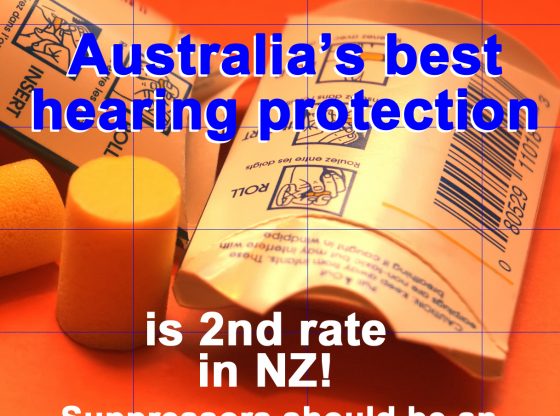Fine for New Zealand but too good for Australia?
Suppressors are widely used in other English-speaking countries as hearing protection. We look carefully at the facts about them and ask: what’s the effect of banning them for Australian shooters?
Noise and hearing loss
The use of common centrefire cartridges (for example, 9mm Luger) at any pistol range produces noise exceeding 150 dB, direct exposure to any of which is far above any recommended safe limit. WorkCover Queensland indicates there is no safe limit for the use of firearms without hearing protection. That is to say: all direct exposure to noise from discharging firearms causes immediate hearing damage.
The best practice for reducing exposure to noise is controlling noise at the source. The last and inferior option is fitting hearing protection to users. Fitting hearing protection to users is prone to human error and too frequently fails to protect the delicate apparatus of human hearing. The proposition that best practice involves engineering measures to reduce noise at the source of the noise as a first choice is reinforced by national guidelines which explain.
10.1 When engineering and administrative noise control measures do not reduce the exposure to noise to or below the National Standard for Occupational Noise [NOHSC: 1007(2000)] employees should be supplied with, and wear, effective personal hearing protectors.
10.2 Personal hearing protectors should not be used when noise control by engineering or administrative noise control measures is practicable. They should normally be regarded as an interim measure while control of excessive noise is being achieved by these other means.
Hearing protection and suppressors
The literature indicates that the use of one set of hearing protection may reduce exposure by around 30dB while double protection may reduce exposure by around 50 dB. While a reduction of exposure by 50dB may be a good level of reduction, if thousands of shots are being fired in a single club meeting, the then exposure to levels exceeding 100 dB is still a substantial exposure.
Double hearing protection noticeably impedes a person’s ability to hear and communicate with the range officer(s), even when they use noise-cancelling headphones (which not all participants use). The inner earplugs dampen the amplification of a range officer’s voice by the outer noise-cancelling headphones.
Many participants at a range elect not to use two layers of hearing protection, yet their hearing loss nevertheless looms as a long term public health and productivity issue even if they are complicit in it.
The cost of banning suppressors
As of 12 years ago, about 37% of hearing loss in Australia is noise-induced and that it is inferable that the overall economic cost of that exceeds $4Bn annually. The expansion of this cost into the future is vast.
Sound suppressors on a 9mm Luger pistol, such as a Beretta 92F, may reduce the noise at discharge by up to 31dB (Page 358 of Silencer: History & Performance Volume 1, Paulson, AC, ISBN 0-87364-909-5). Even with the use of a suppressor, the sound produced by a firearm is loud and still demands hearing protection.
Scale of sport
There are over ten thousand pistol shooters in Queensland alone. The majority shoot at least one centrefire pistol for practice or competition between weekly and several times a year. Centrefire pistols generally produce a sound at the firing line exceeding 150dB.
At a small range there may be a dozen competitors gathered, firing 30 shots in competition and perhaps another 60 for practice. This is over a thousand shots to which all persons present on the range are exposed to some extent. The literature suggests most participants already receive a high-level of exposure, perhaps even the daily limit of exposure, even when wearing double hearing protection. If there are more competitors, more practice time or a longer competition, then it is obvious that the total exposure may exceed safe daily limits – especially for a range officer at the firing line even when wearing double hearing protection.
Suppressors are available, but tightly restricted, in some Australian States. They should be widely available to licensed, law-abiding firearm owners – just like they are in New Zealand.

